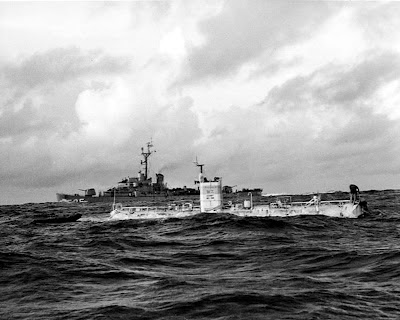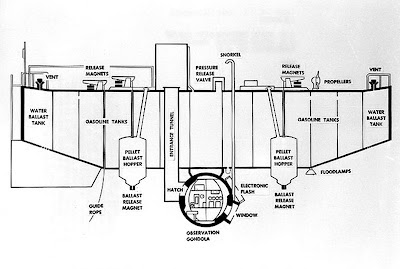Bathyscaphe Trieste Marianas Trench Challenger Deep FREE PHOTOS - In October 1959, after being fitted with a stronger pressure sphere, Trieste was transported to the mid-Pacific to participate in Project "Nekton", in which she conducted a series of very deep dives in the Marianas Trench. On 23 January 1960, she reached a record depth of 35,800 feet in the Challenger Deep, off Guam, the deepest point in any of the World's oceans.
Photo 1 #: NH 96799 U.S. Navy Bathyscaphe Trieste (1958-1963)
Is hoisted from the water by a floating crane, during testing by the Naval Electronics Laboratory in the San Diego, California, area. Trieste was being prepared for transportation to the Marianas Islands for a three-month series of deep-submergence operations. On 2 October 1959, she was loaded on the frieghter Santa Maria for the trip to the mid-Pacific.
U.S. NHHC Photograph.
Photo 2 #: NH 96797 U.S. Navy Bathyscaphe Trieste (1958-1963)
Just before her record dive to the bottom of the Marianas Trench, 23 January 1960. The dive, to a depth of 35,800 feet in the Challenger Deep, off Guam, was made with Lieutenant Don Walsh, USN, and Swiss scientist Jacques Piccard on board. Waves were about five to six feet high when the two men boarded Trieste from the rubber raft seen at left.
USS Lewis (DE-535) is steaming by in the background.
U.S. NHHC Photograph.
Photo 3 #: NH 96807 U.S. Navy Bathyscaphe Trieste (1958-1963)
General arrangement drawing, showing the bathyscaphe's main features. Drawing was released in connection with Trieste's record dive to 35,800 feet in the Challenger Deep, off Guam, on 23 January 1960.
U.S. NHHC Photograph.
Notice: Privacy Policy
1. This is a World Wide Web site for official information about the Naval History and Heritage Command (NHHC) and naval history. It is provided as a public service by the NHHC. The purpose is to provide information and news about the Naval History and Heritage Command and naval history to the general public.
2. All information on this site is in the public domain and may be distributed or copied unless otherwise specified. Use of appropriate byline/photo/image credits is requested.
This file is a work of a United States Department of Defence employee, taken or made during the course of the person's official duties. As a work of the U.S. federal government, the file is in the public domain.
Generally speaking, works created by U.S. Government employees are not eligible for copyright protection in the United States. See Circular 1 "COPYRIGHT BASICS" PDF from the U.S. Copyright Office. +sookie tex
TEXT and IMAGE CREDIT: Naval History and Heritage Command
















No comments:
Post a Comment